Modeling and Force Analysis of an Electrothermal Micro Gripper with Amplification Compliant Mechanism
This work reports a novel design of a micro gripper, in which V-shaped electrothermal actuators are used to
create gripping force and a compliant mechanism is integrated to amplify displacements of the actuators.
The gripper is designed to handle micro samples of various sizes from 5 m to 50 m by applying
appropriate driving voltages. Those voltages are ranged from 5 V to 25 V, which are relatively low in
comparison with driving voltages of the electrostatic micro grippers. The compliant mechanism with
amplifying ratio 5.2, arranged between the actuators and the jaws, is aimed to compensate small strokes of
the actuators. Simulation by Finite-Element Analysis has also been carried out to confirm results of the
theoretical calculation and designing process. The micro gripper can be implemented in micro devices such
as micro robots or micro assembling systems, in which it can perform gripping and transporting tasks.
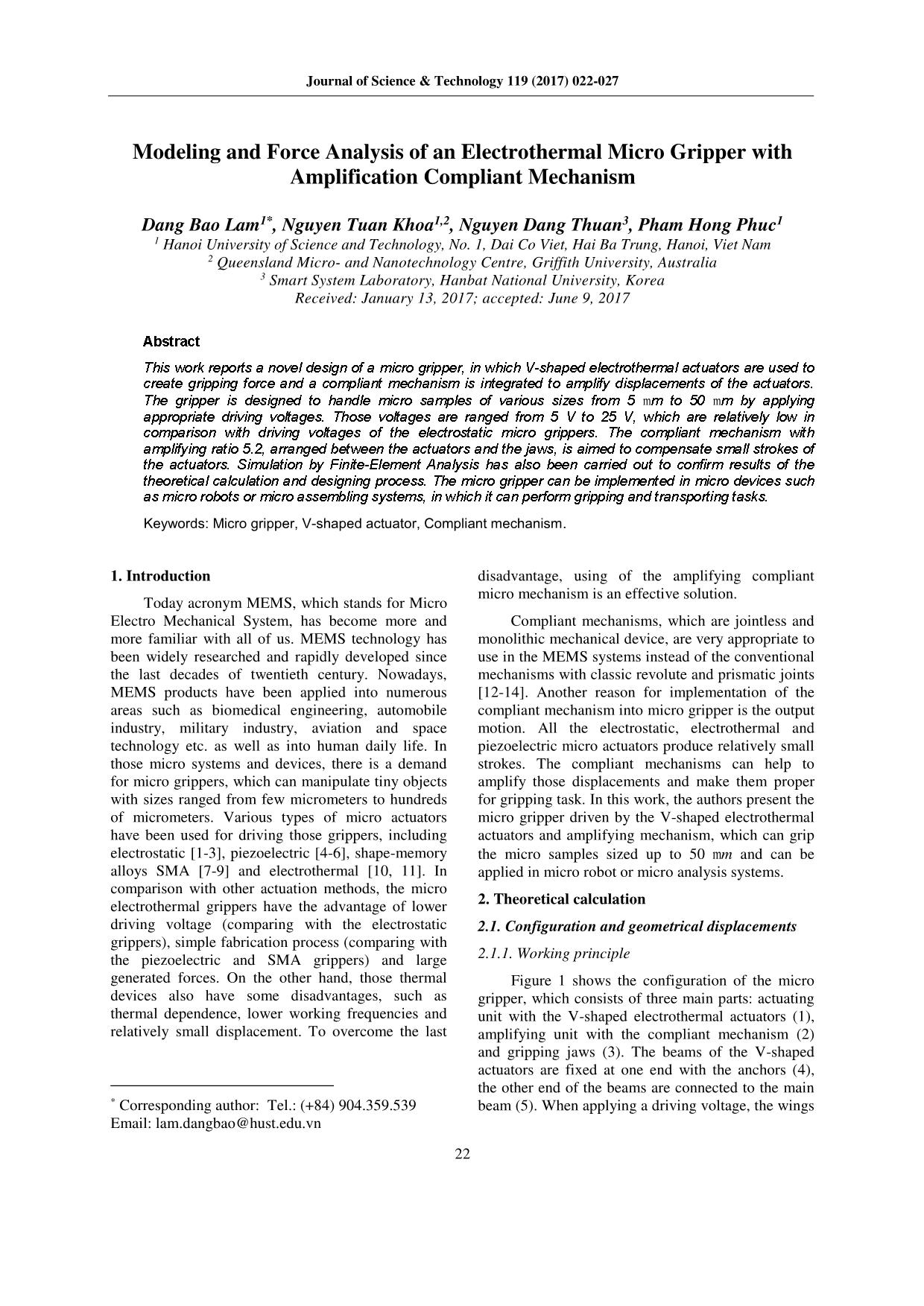
Trang 1
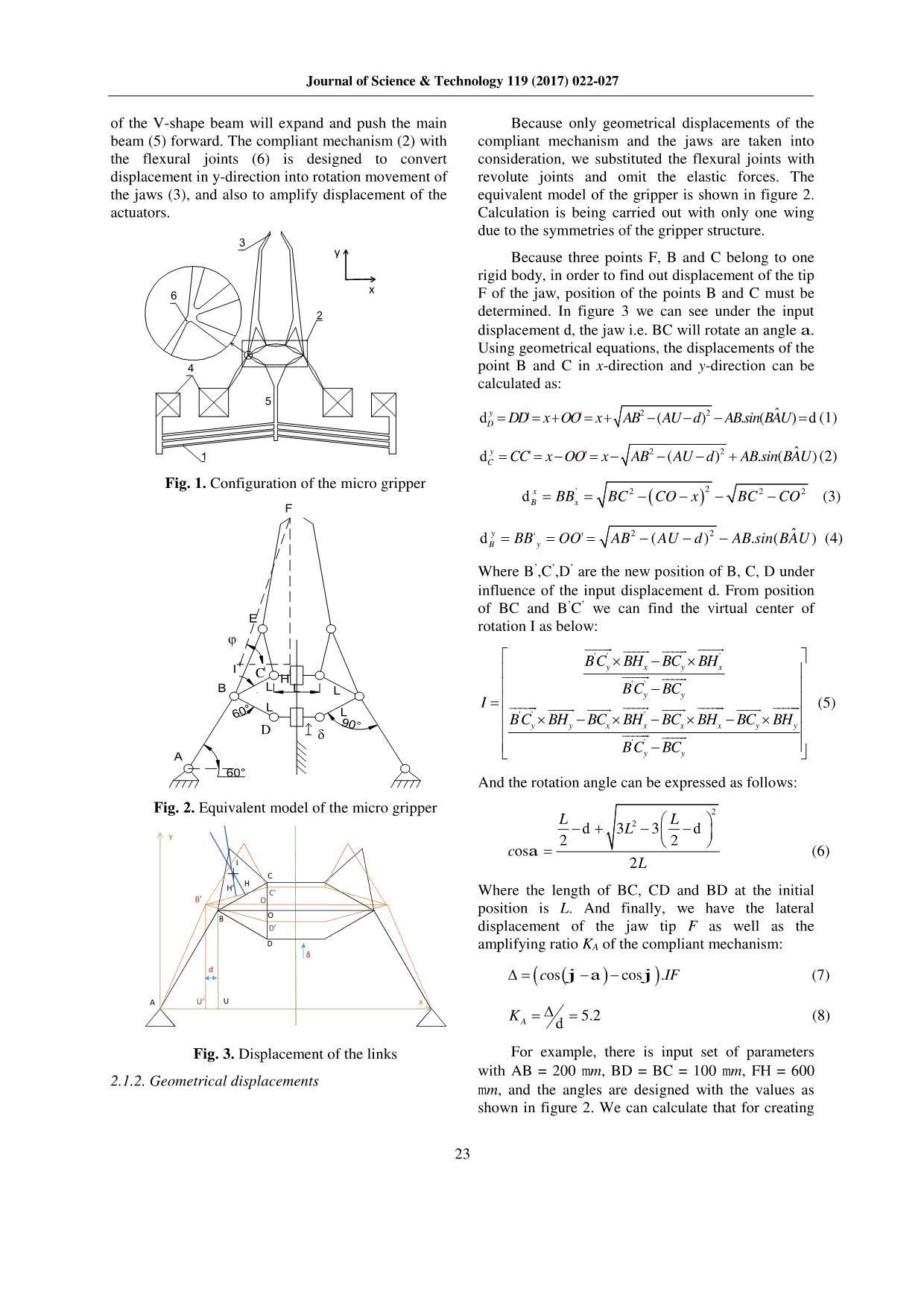
Trang 2
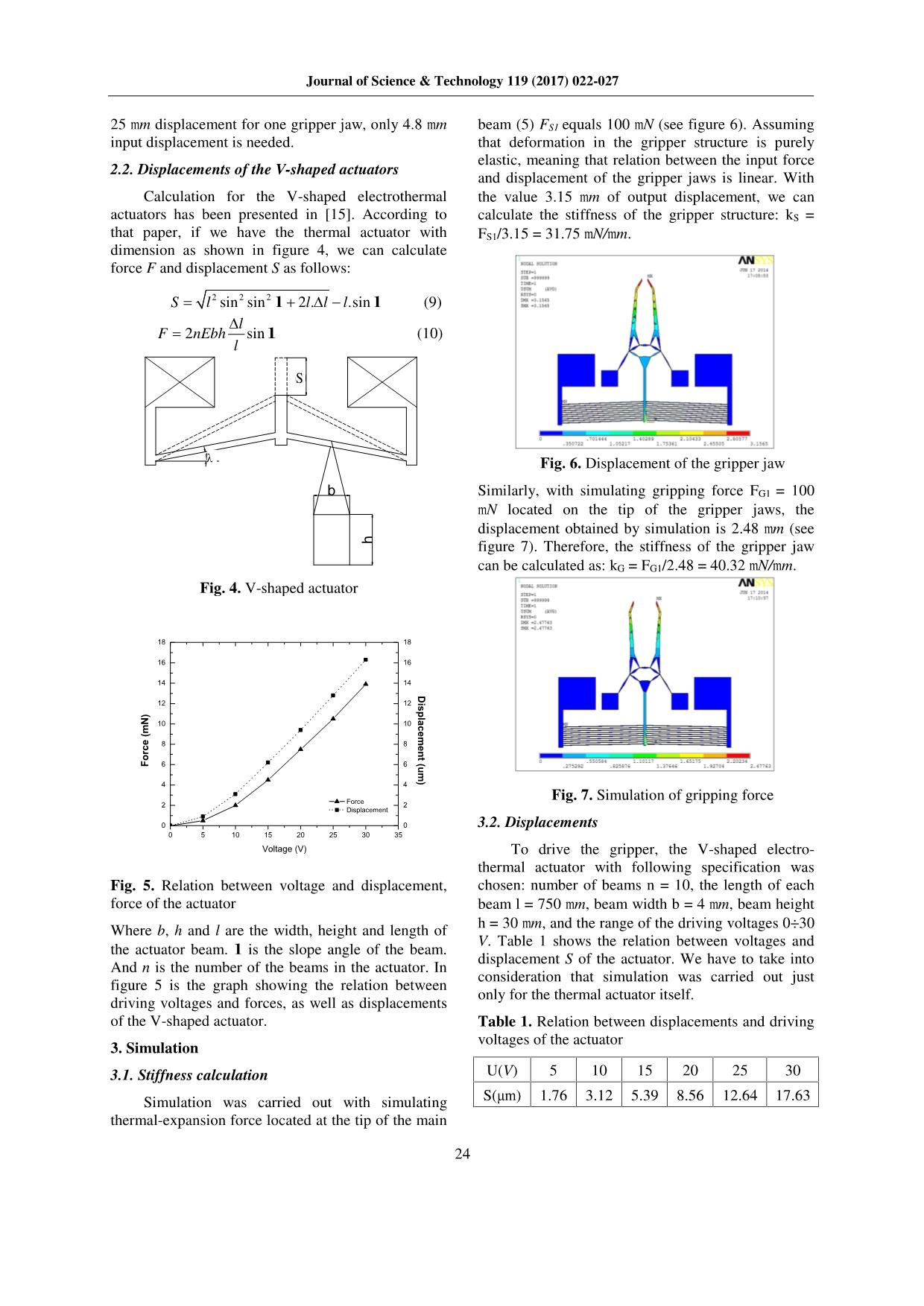
Trang 3
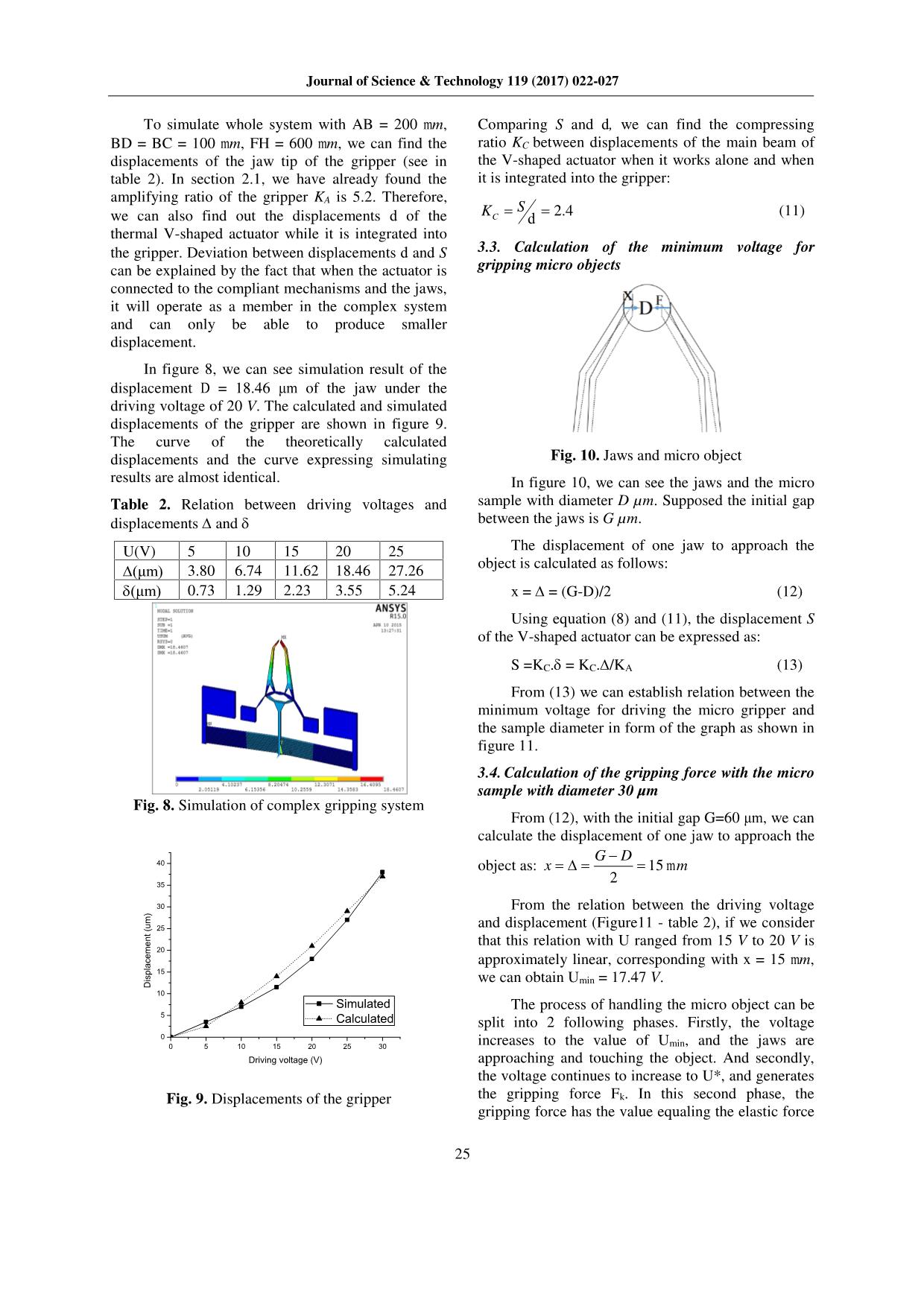
Trang 4
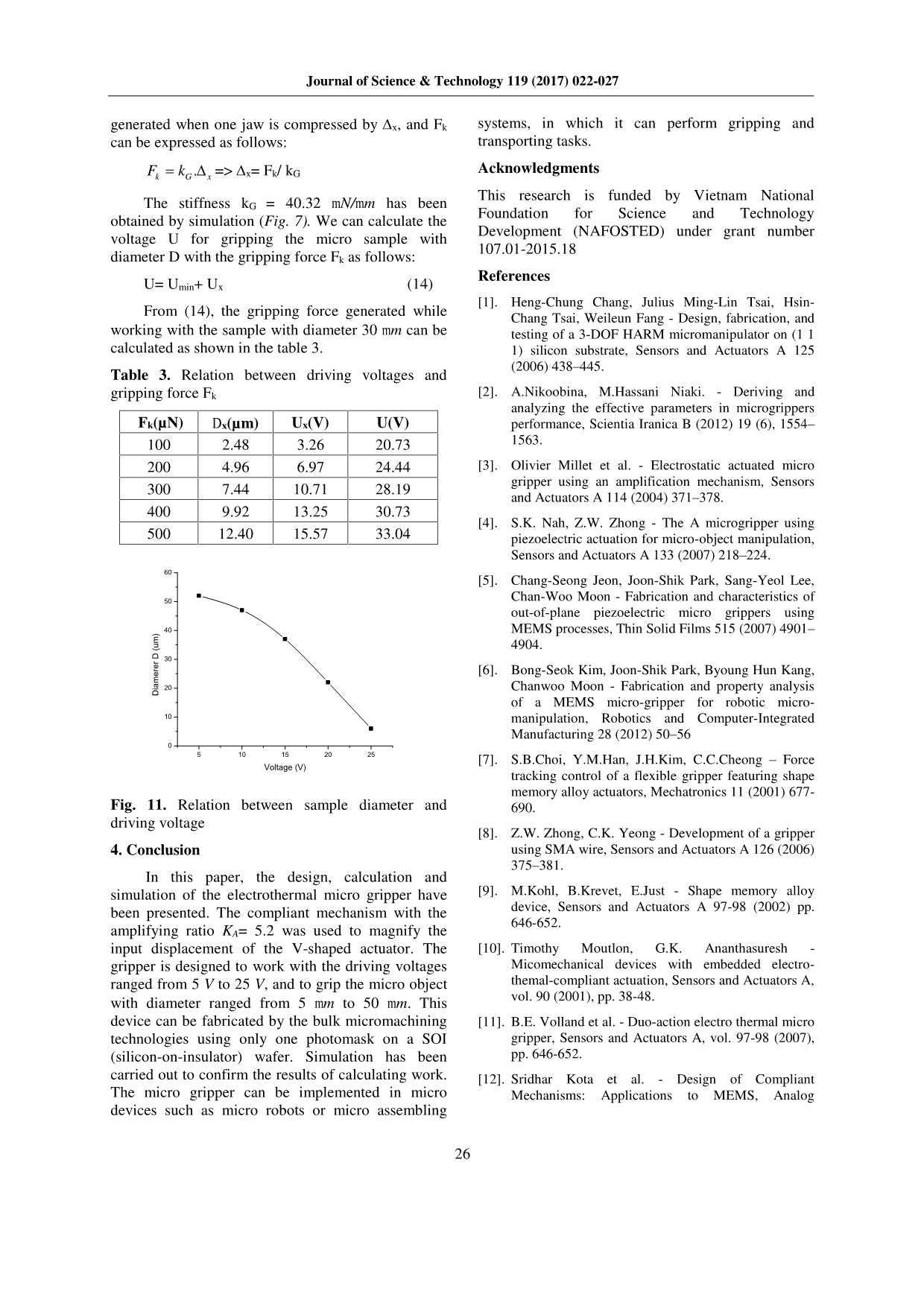
Trang 5

Trang 6
Tóm tắt nội dung tài liệu: Modeling and Force Analysis of an Electrothermal Micro Gripper with Amplification Compliant Mechanism
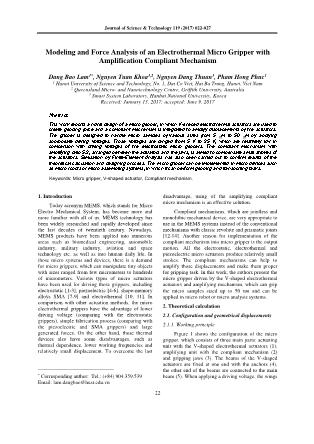
Journal of Science & Technology 119 (2017) 022-027
22
Modeling and Force Analysis of an Electrothermal Micro Gripper with
Amplification Compliant Mechanism
Dang Bao Lam1*, Nguyen Tuan Khoa1,2, Nguyen Dang Thuan3, Pham Hong Phuc1
1 Hanoi University of Science and Technology, No. 1, Dai Co Viet, Hai Ba Trung, Hanoi, Viet Nam
2 Queensland Micro- and Nanotechnology Centre, Griffith University, Australia
3 Smart System Laboratory, Hanbat National University, Korea
Received: January 13, 2017; accepted: June 9, 2017
Abstract
This work reports a novel design of a micro gripper, in which V-shaped electrothermal actuators are used to
create gripping force and a compliant mechanism is integrated to amplify displacements of the actuators.
The gripper is designed to handle micro samples of various sizes from 5 m to 50 m by applying
appropriate driving voltages. Those voltages are ranged from 5 V to 25 V, which are relatively low in
comparison with driving voltages of the electrostatic micro grippers. The compliant mechanism with
amplifying ratio 5.2, arranged between the actuators and the jaws, is aimed to compensate small strokes of
the actuators. Simulation by Finite-Element Analysis has also been carried out to confirm results of the
theoretical calculation and designing process. The micro gripper can be implemented in micro devices such
as micro robots or micro assembling systems, in which it can perform gripping and transporting tasks.
Keywords: Micro gripper, V-shaped actuator, Compliant mechanism.
1. Introduction*
Today acronym MEMS, which stands for Micro
Electro Mechanical System, has become more and
more familiar with all of us. MEMS technology has
been widely researched and rapidly developed since
the last decades of twentieth century. Nowadays,
MEMS products have been applied into numerous
areas such as biomedical engineering, automobile
industry, military industry, aviation and space
technology etc. as well as into human daily life. In
those micro systems and devices, there is a demand
for micro grippers, which can manipulate tiny objects
with sizes ranged from few micrometers to hundreds
of micrometers. Various types of micro actuators
have been used for driving those grippers, including
electrostatic [1-3], piezoelectric [4-6], shape-memory
alloys SMA [7-9] and electrothermal [10, 11]. In
comparison with other actuation methods, the micro
electrothermal grippers have the advantage of lower
driving voltage (comparing with the electrostatic
grippers), simple fabrication process (comparing with
the piezoelectric and SMA grippers) and large
generated forces. On the other hand, those thermal
devices also have some disadvantages, such as
thermal dependence, lower working frequencies and
relatively small displacement. To overcome the last
* Corresponding author: Tel.: (+84) 904.359.539
Email: lam.dangbao@hust.edu.vn
disadvantage, using of the amplifying compliant
micro mechanism is an effective solution.
Compliant mechanisms, which are jointless and
monolithic mechanical device, are very appropriate to
use in the MEMS systems instead of the conventional
mechanisms with classic revolute and prismatic joints
[12-14]. Another reason for implementation of the
compliant mechanism into micro gripper is the output
motion. All the electrostatic, electrothermal and
piezoelectric micro actuators produce relatively small
strokes. The compliant mechanisms can help to
amplify those displacements and make them proper
for gripping task. In this work, the authors present the
micro gripper driven by the V-shaped electrothermal
actuators and amplifying mechanism, which can grip
the micro samples sized up to 50 m and can be
applied in micro robot or micro analysis systems.
2. Theoretical calculation
2.1. Configuration and geometrical displacements
2.1.1. Working principle
Figure 1 shows the configuration of the micro
gripper, which consists of three main parts: actuating
unit with the V-shaped electrothermal actuators (1),
amplifying unit with the compliant mechanism (2)
and gripping jaws (3). The beams of the V-shaped
actuators are fixed at one end with the anchors (4),
the other end of the beams are connected to the main
beam (5). When applying a driving voltage, the wings
Journal of Science & Technology 119 (2017) 022-027
23
of the V-shape beam will expand and push the main
beam (5) forward. The compliant mechanism (2) with
the flexural joints (6) is designed to convert
displacement in y-direction into rotation movement of
the jaws (3), and also to amplify displacement of the
actuators.
3
0
1
4
2
6
y
x
3
4
5
6
Fig. 1. Configuration of the micro gripper
D
L
L
L
L
L
W
A
B
D
C
E
F
I
60°
60°
90°
H
C
D
Fig. 2. Equivalent model of the micro gripper
C’
O
D’
D
y
B
C
O’
I
A xU’ U
δ
B’
HH’
d
Fig. 3. Displacement of the links
2.1.2. Geometrical displacements
Because only geometrical displacements of the
compliant mechanism and the jaws are taken into
consideration, we substituted the flexural joints with
revolute joints and omit the elastic forces. The
equivalent model of the gripper is shown in figure 2.
Calculation is being carried out with only one wing
due to the symmetries of the gripper structure.
Because three points F, B and C belong to one
rigid body, in order to find out displacement of the tip
F of the jaw, position of the points B and C must be
determined. In figure 3 we can see under the input
displacement , the jaw i.e. BC will rotate an angle .
Using geometrical equations, the displacements of the
point B and C in x-direction and y-direction can be
calculated as:
2 2 ˆ( ) (.' ' )yD DD x OO x AB AU d ABsin BAU (1)
2 2 ˆ(' ' ) ( ).yC CC x OO x AB AU d AB sin BAU (2)
2' 2 2 2xB xBB BC CO x BC CO (3)
2 2
' ( ( )' . ˆ)yyB BB OO AB AU d AB sin BAU (4)
Where B’,C’,D’ are the new position of B, C, D under
influence of the input displacement . From position
of BC and B’C’ we can find the virtual center of
rotation I as below:
' ' '
' '
' ' '
' '
y x y x
y y
y y x x x x y y
y y
BC BH BC BH
BC BC
I
BC BH BC BH BC BH BC BH
BC BC
(5)
And the rotation angle can be expressed as follows:
2
23 3
2 2
os
2
L LL
c
L
(6)
Where the length of BC, CD and BD at the initial
position is L. And finally, we have the lateral
displacement of the jaw tip F as well as the
amplifying ratio KA of the compliant mechanism:
os cos .c IF (7)
5.2AK
(8)
For example, there is input set of parameters
with AB = 200 m, BD = BC = 100 m, FH = 600
m, and the angles are designed with the values as
shown in figure 2. We can calculate that for creating
Journal of Science & Technology 119 (2017) 022-027
24
25 m displacement for one gripper jaw, only 4.8 m
input displacement is needed.
2.2. Displacements of the V-shaped actuators
Calculation for the V-shaped electrothermal
actuators has been presented in [15]. According to
that paper, if we have the thermal actuator with
dimension as shown in figure 4, we can calculate
force F and displacement S as follows:
2 2 2sin sin 2 . .sinS l l l l (9)
2 sinlF nEbh
l
(10)
0 5 10 15 20 25 30 35
0
2
4
6
8
10
12
14
16
18
Force
Displacement
Voltage (V)
Fo
rce
(m
N)
0
2
4
6
8
10
12
14
16
18
Displacement (um)
Fig. 5. Relation between voltage and displacement,
force of the actuator
Where b, h and l are the width, height and length of
the actuator beam. is the slope angle of the beam.
And n is the number of the beams in the actuator. In
figure 5 is the graph showing the relation between
driving voltages and forces, as well as displacements
of the V-shaped actuator.
3. Simulation
3.1. Stiffness calculation
Simulation was carried out with simulating
thermal-expansion force located at the tip of the main
beam (5) FS1 equals 100 N (see figure 6). Assuming
that deformation in the gripper structure is purely
elastic, meaning that relation between the input force
and displacement of the gripper jaws is linear. With
the value 3.15 m of output displacement, we can
calculate the stiffness of the gripper structure: kS =
FS1/3.15 = 31.75 N/m.
Fig. 6. Displacement of the gripper jaw
Similarly, with simulating gripping force FG1 = 100
N located on the tip of the gripper jaws, the
displacement obtained by simulation is 2.48 m (see
figure 7). Therefore, the stiffness of the gripper jaw
can be calculated as: kG = FG1/2.48 = 40.32 N/m.
Fig. 7. Simulation of gripping force
3.2. Displacements
To drive the gripper, the V-shaped electro-
thermal actuator with following specification was
chosen: number of beams n = 10, the length of each
beam l = 750 m, beam width b = 4 m, beam height
h = 30 m, and the range of the driving voltages 0÷30
V. Table 1 shows the relation between voltages and
displacement S of the actuator. We have to take into
consideration that simulation was carried out just
only for the thermal actuator itself.
Table 1. Relation between displacements and driving
voltages of the actuator
U(V) 5 10 15 20 25 30
S(μm) 1.76 3.12 5.39 8.56 12.64 17.63
Fig. 4. V-shaped actuator
b
h
D
a
S
Journal of Science & Technology 119 (2017) 022-027
25
To simulate whole system with AB = 200 m,
BD = BC = 100 m, FH = 600 m, we can find the
displacements of the jaw tip of the gripper (see in
table 2). In section 2.1, we have already found the
amplifying ratio of the gripper KA is 5.2. Therefore,
we can also find out the displacements of the
thermal V-shaped actuator while it is integrated into
the gripper. Deviation between displacements and S
can be explained by the fact that when the actuator is
connected to the compliant mechanisms and the jaws,
it will operate as a member in the complex system
and can only be able to produce smaller
displacement.
In figure 8, we can see simulation result of the
displacement = 18.46 μm of the jaw under the
driving voltage of 20 V. The calculated and simulated
displacements of the gripper are shown in figure 9.
The curve of the theoretically calculated
displacements and the curve expressing simulating
results are almost identical.
Table 2. Relation between driving voltages and
displacements and
U(V) 5 10 15 20 25
(μm) 3.80 6.74 11.62 18.46 27.26
(μm) 0.73 1.29 2.23 3.55 5.24
Fig. 8. Simulation of complex gripping system
0 5 10 15 20 25 30
0
5
10
15
20
25
30
35
40
Dis
pla
ce
me
nt
(um
)
Driving voltage (V)
Simulated
Calculated
Fig. 9. Displacements of the gripper
Comparing S and , we can find the compressing
ratio KC between displacements of the main beam of
the V-shaped actuator when it works alone and when
it is integrated into the gripper:
2.4C SK (11)
3.3. Calculation of the minimum voltage for
gripping micro objects
Fig. 10. Jaws and micro object
In figure 10, we can see the jaws and the micro
sample with diameter D µm. Supposed the initial gap
between the jaws is G µm.
The displacement of one jaw to approach the
object is calculated as follows:
x = = (G-D)/2 (12)
Using equation (8) and (11), the displacement S
of the V-shaped actuator can be expressed as:
S =KC. = KC. /KA (13)
From (13) we can establish relation between the
minimum voltage for driving the micro gripper and
the sample diameter in form of the graph as shown in
figure 11.
3.4. Calculation of the gripping force with the micro
sample with diameter 30 µm
From (12), with the initial gap G=60 μm, we can
calculate the displacement of one jaw to approach the
object as: 15
2
G D
x m
From the relation between the driving voltage
and displacement (Figure11 - table 2), if we consider
that this relation with U ranged from 15 V to 20 V is
approximately linear, corresponding with x = 15 m,
we can obtain Umin = 17.47 V.
The process of handling the micro object can be
split into 2 following phases. Firstly, the voltage
increases to the value of Umin, and the jaws are
approaching and touching the object. And secondly,
the voltage continues to increase to U*, and generates
the gripping force Fk. In this second phase, the
gripping force has the value equaling the elastic force
Journal of Science & Technology 119 (2017) 022-027
26
generated when one jaw is compressed by x, and Fk
can be expressed as follows:
.k G xF k => x= Fk/ kG
The stiffness kG = 40.32 N/m has been
obtained by simulation (Fig. 7). We can calculate the
voltage U for gripping the micro sample with
diameter D with the gripping force Fk as follows:
U= Umin+ Ux (14)
From (14), the gripping force generated while
working with the sample with diameter 30 m can be
calculated as shown in the table 3.
Table 3. Relation between driving voltages and
gripping force Fk
Fk(µN) x(µm) Ux(V) U(V)
100 2.48 3.26 20.73
200 4.96 6.97 24.44
300 7.44 10.71 28.19
400 9.92 13.25 30.73
500 12.40 15.57 33.04
5 10 15 20 25
0
10
20
30
40
50
60
Dia
me
rer
D
(um
)
Voltage (V)
Fig. 11. Relation between sample diameter and
driving voltage
4. Conclusion
In this paper, the design, calculation and
simulation of the electrothermal micro gripper have
been presented. The compliant mechanism with the
amplifying ratio KA= 5.2 was used to magnify the
input displacement of the V-shaped actuator. The
gripper is designed to work with the driving voltages
ranged from 5 V to 25 V, and to grip the micro object
with diameter ranged from 5 m to 50 m. This
device can be fabricated by the bulk micromachining
technologies using only one photomask on a SOI
(silicon-on-insulator) wafer. Simulation has been
carried out to confirm the results of calculating work.
The micro gripper can be implemented in micro
devices such as micro robots or micro assembling
systems, in which it can perform gripping and
transporting tasks.
Acknowledgments
This research is funded by Vietnam National
Foundation for Science and Technology
Development (NAFOSTED) under grant number
107.01-2015.18
References
[1]. Heng-Chung Chang, Julius Ming-Lin Tsai, Hsin-
Chang Tsai, Weileun Fang - Design, fabrication, and
testing of a 3-DOF HARM micromanipulator on (1 1
1) silicon substrate, Sensors and Actuators A 125
(2006) 438–445.
[2]. A.Nikoobina, M.Hassani Niaki. - Deriving and
analyzing the effective parameters in microgrippers
performance, Scientia Iranica B (2012) 19 (6), 1554–
1563.
[3]. Olivier Millet et al. - Electrostatic actuated micro
gripper using an amplification mechanism, Sensors
and Actuators A 114 (2004) 371–378.
[4]. S.K. Nah, Z.W. Zhong - The A microgripper using
piezoelectric actuation for micro-object manipulation,
Sensors and Actuators A 133 (2007) 218–224.
[5]. Chang-Seong Jeon, Joon-Shik Park, Sang-Yeol Lee,
Chan-Woo Moon - Fabrication and characteristics of
out-of-plane piezoelectric micro grippers using
MEMS processes, Thin Solid Films 515 (2007) 4901–
4904.
[6]. Bong-Seok Kim, Joon-Shik Park, Byoung Hun Kang,
Chanwoo Moon - Fabrication and property analysis
of a MEMS micro-gripper for robotic micro-
manipulation, Robotics and Computer-Integrated
Manufacturing 28 (2012) 50–56
[7]. S.B.Choi, Y.M.Han, J.H.Kim, C.C.Cheong – Force
tracking control of a flexible gripper featuring shape
memory alloy actuators, Mechatronics 11 (2001) 677-
690.
[8]. Z.W. Zhong, C.K. Yeong - Development of a gripper
using SMA wire, Sensors and Actuators A 126 (2006)
375–381.
[9]. M.Kohl, B.Krevet, E.Just - Shape memory alloy
device, Sensors and Actuators A 97-98 (2002) pp.
646-652.
[10]. Timothy Moutlon, G.K. Ananthasuresh -
Micomechanical devices with embedded electro-
themal-compliant actuation, Sensors and Actuators A,
vol. 90 (2001), pp. 38-48.
[11]. B.E. Volland et al. - Duo-action electro thermal micro
gripper, Sensors and Actuators A, vol. 97-98 (2007),
pp. 646-652.
[12]. Sridhar Kota et al. - Design of Compliant
Mechanisms: Applications to MEMS, Analog
Journal of Science & Technology 119 (2017) 022-027
27
Integrated Circuits and Signal Processing (2001),
29,pp. 7–15.
[13]. Xiantao Sun, Weihai Chen, Yanling Tian, Sergej
Fatikow,Rui Zhou, Jianbin Zhang, and Manuel
Mikczinski - A novel flexure-based microgripper with
double amplification mechanisms for micro/nano
manipulation, Review of Scientific Instruments 84,
085002 (2013).
[14]. Byoung Hun Kang, John T. Wen - Design of
Compliant MEMS Grippers for Micro-Assembly
Tasks, Proceedings of the 2006 IEEE/RSJ,
DOI: 10.1109/IROS.2006.282626.
[15]. Nguyen Tuan Khoa, Dang Bao Lam, Dinh Khac
Toan, Phạm Hong Phuc - Design and fabrication of
the micro bi-directional motor driven by electro-
thermal actuators, Journal of Science and
Technology, Vol. 69(2013), pp. 62-68.
File đính kèm:
 modeling_and_force_analysis_of_an_electrothermal_micro_gripp.pdf
modeling_and_force_analysis_of_an_electrothermal_micro_gripp.pdf

